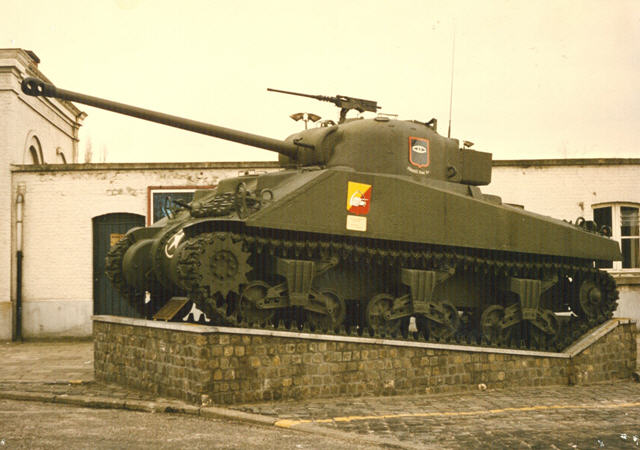The Sherman-Story
by Jozef GEBOERS - Translation by Patrick Marquenie

During the springtime of 1984 the president of the tradespeople, Ray Verpoorten, was attending the farewell parade of Lieutenant-general Dewandre of the Group Leopard (Groep Leopard). The general will become the president of the division tanks at the Royal Museum in Brussels. During the reception, Verpoorten told the general that a village like Leopoldsburg should have a Sherman tank as a monument. The general agreed and promised a Sherman tank.
Later that year, Lieutenant-colonel Van Thienen, then commander of Group Leopard, his successor Lieutenant-colonel Pauwels W., and Commandant Geboers visited the Dutch driving school and traction school. Lieutenant-colonel Van Thienen remembered the promise of the general and told this toLieutenat-colonel Pauwels. Pauwels assigned Commandant Geboers to fulfill that promise.
At that time Commandant Geboers was the commander of the Platoon maintenance of Group Leopard and had all the necessary means for hoisting and renovating at his disposal.
Transport needed to be requested.
General Dewandre was reminded of his promise and he send a photo catalog with all known tank wrecks in Belgium. In this catalog, a tank, which was on the shooting range of Brasschaat, was appointed to be renovated and become a monument for Leopoldsburg.
During a visit to the shooting range, Commandant Geboers noticed that the appointed Sherman, which stood at the entrance,
had been used as a target for
‘Energa’ and ‘Blindicide’, portable anti-tank weapons.
They had perforated the Sherman in more than 100 places with their shaped charge. After a consultation
with the responsable of the range,
they decided to recuperate another Sherman. Deep in the square, in the swamp, there was another Sherman which hadn’t
been cataloged. This Sherman had been used as
an artillery target for 15 years, but was still usable as a future monument. One
weekend later a first attempt was taken with personnel and a
Recovery Leopard of the 18th RA (18de Rijdende Artillerie) . They didn’t have much experience with the Recovery Leopard and the Sherman remained stuck in the swamp.

The next weekend a second attempt with personnel of Group Leopard was more successful. The Sherman was pulled out of the mud onto a sand track. The tracks, which were bend as an accordion between the track idlers, were cut into pieces by using the Sherman’s alternator. Now the Sherman could be pulled onto a flatbed trailer of the 1st Cie Mat (1ste Compagnie Materiaal) and be transported to the Group Leopard in Leopoldsburg.





The list with needed parts wasn’t long but was heavy: half a canon, 2 main drive sprockets, 2 track idlers, 1 complete suspension bogie, and 1 track.
On the shooting range of Leopoldsburg, another heavily damaged Sherman had to make room for non-metal targets. Luckily this one could provide the necessary parts, but all had to be done in one afternoon. The powerful Leopard Recovery pulled the turret of the Sherman of its body and turned it over. Since the bolts were in a rut, their heads were removed by using a welding torch. All necessary parts were detached and brought to the Group Leopard. This was at the beginning of August 1984.





The Sherman goes upside down to recover a harness.

In the workplace the turret is placed next to the body. The damaged part of the barrel is burned off and replaced by a part of the recuperated barrel.
The engine, 5 x 6 cylinders, and all unnecessary parts are removed out of the body and sold to a merchant in old iron parts. With the profit, the means for the restoration were bought, mainly grinding discs, wired brushes for angle grinders, and filler paste to mend the holes.
With the wire brushes, all rust was removed, and bulges were ground away.
Particular parts were imitated and welded. The welder performed miracles. He painted the turret and body with a firm priming coat and put three layers of zinc-bearing paint over it.
The turret was put back and was solidly anchored.
In meanwhile Commandant Geboers had drawn the pedestal, which was created perfectly by the village. The slope, backstop, direction, and space for the flatbed trailer and Recovery Leopard were taken into account. On October 2 1984 the 1st Cie Mat drove their flatbed trailer in front of the pedestal. While the Recovery Leopard was pulling the Sherman on the pedestal, the men of the 1st Cie Mat were slackening independent cables from the flatbed trailer and managed to put the Sherman with high precision in its place.


Three days later, on October 5 1984, at 18.00Hr, the Sherman was inaugurated by the Minister of Defence Vreven. Lieutenant-colonel Pauwels W. received the honor of firing a final shot above the building, in which 40 years before that the English General Horrocks had given the briefing for Operation Market Garden.
The welder who was sitting in the Sherman brought the barrel back into a horizontal position and screwed it down.
He closed the turret hatch with a padlock and said goodbye to his Sherman.
Leopoldsburg was enriched by one monument.




For the president of the tradespeople, Ray Verpoorten, this was the beginning of fulfilling his dream.
His dream would go much, much further and would be named: M.K.O.K.

This article is also available in
![]() Nederlands
Nederlands